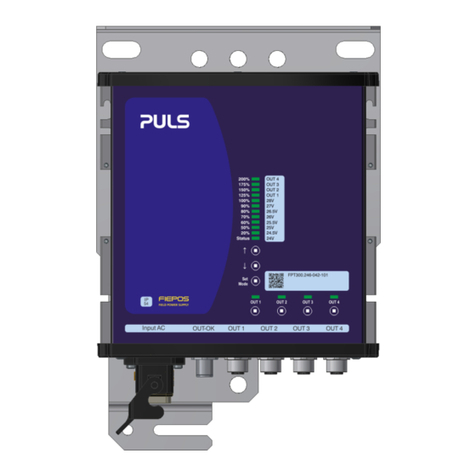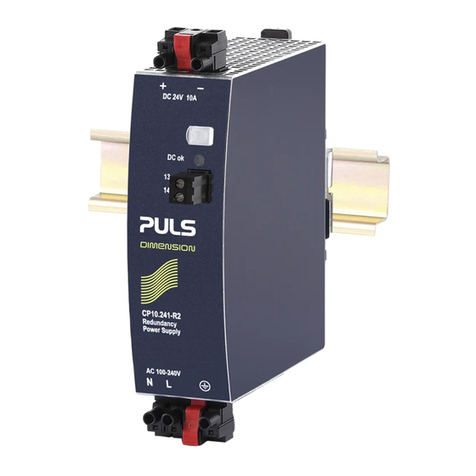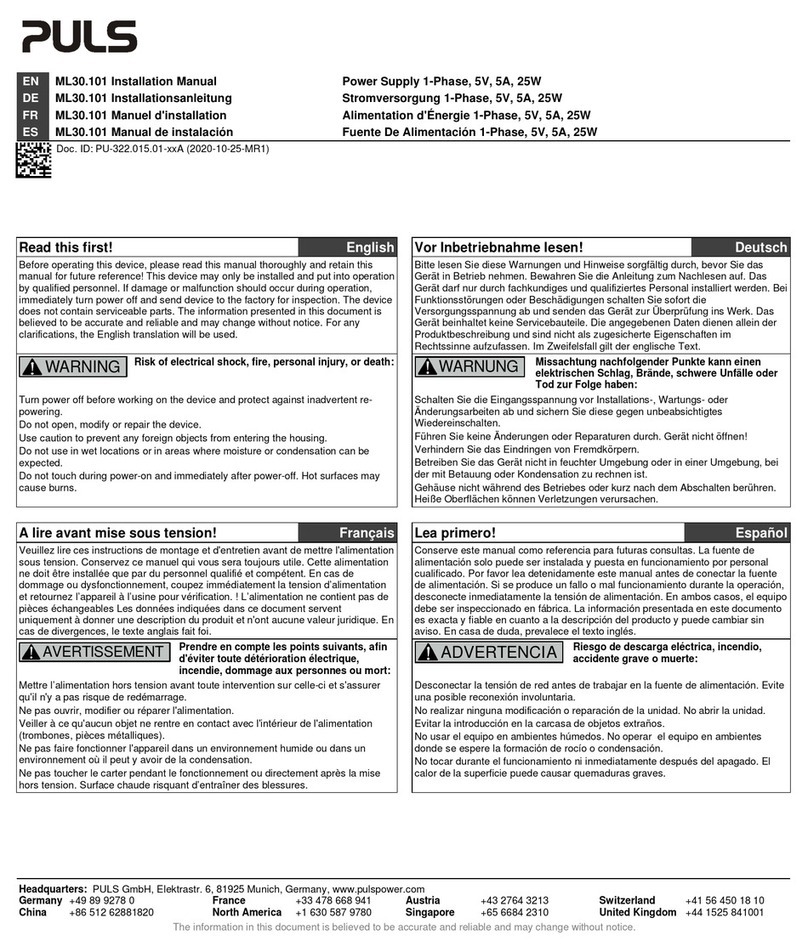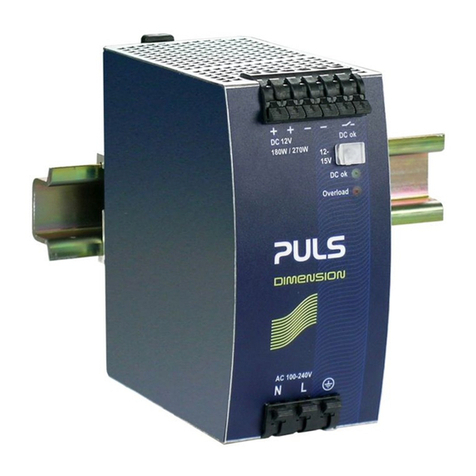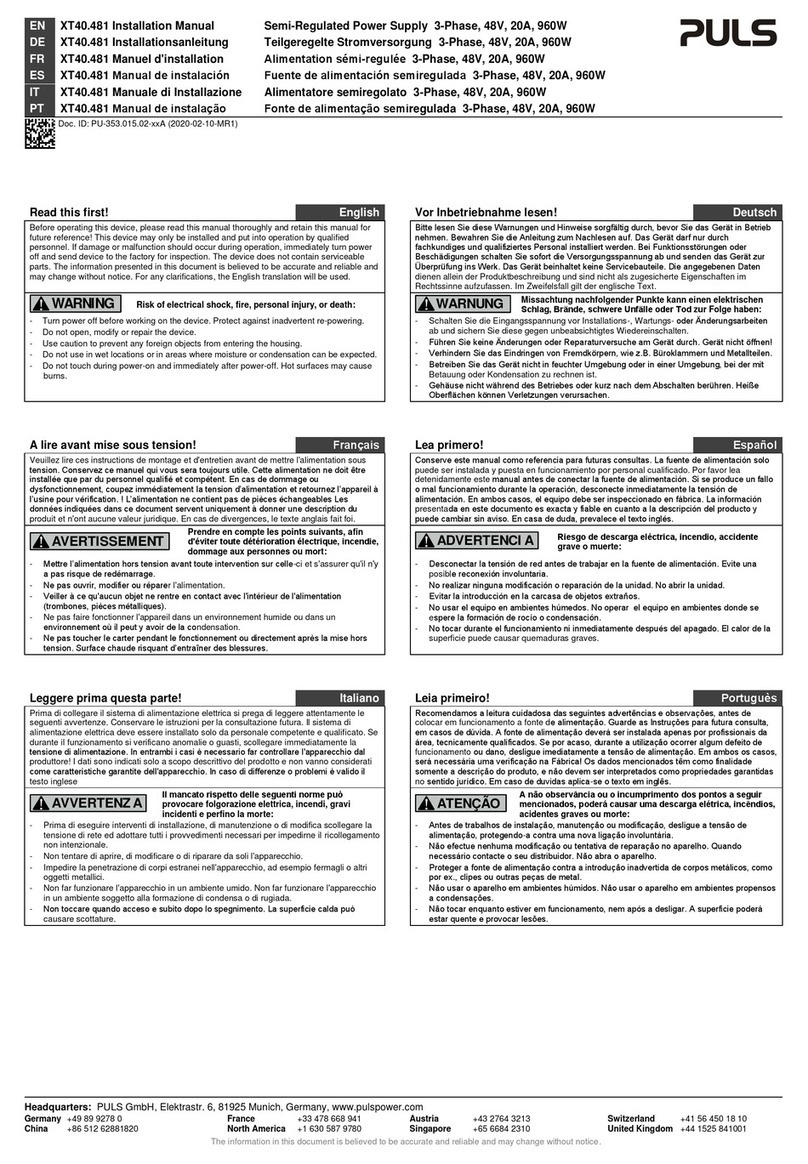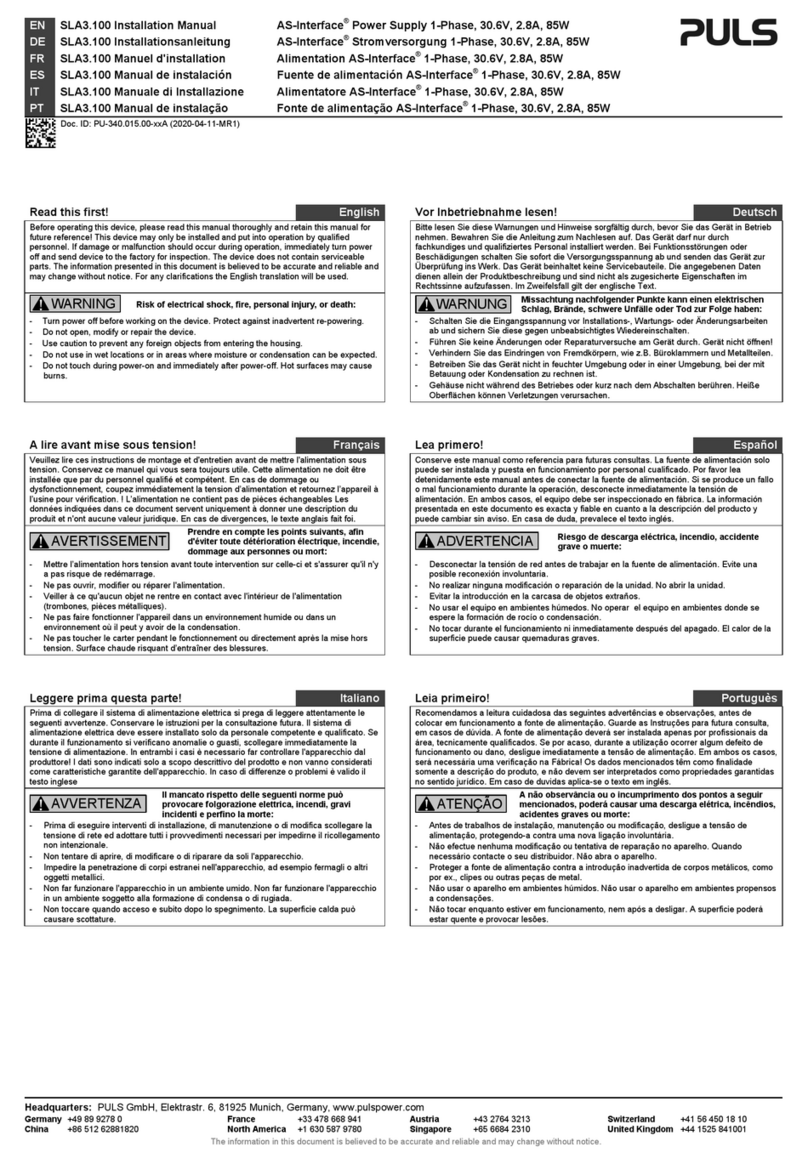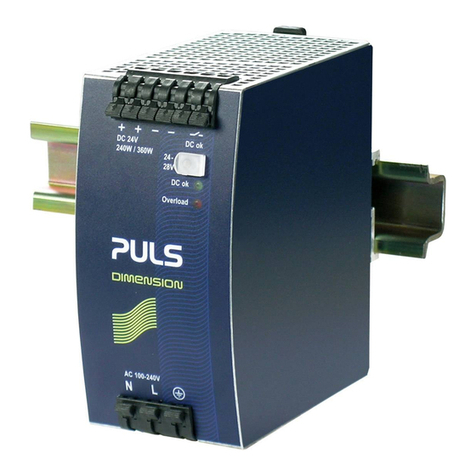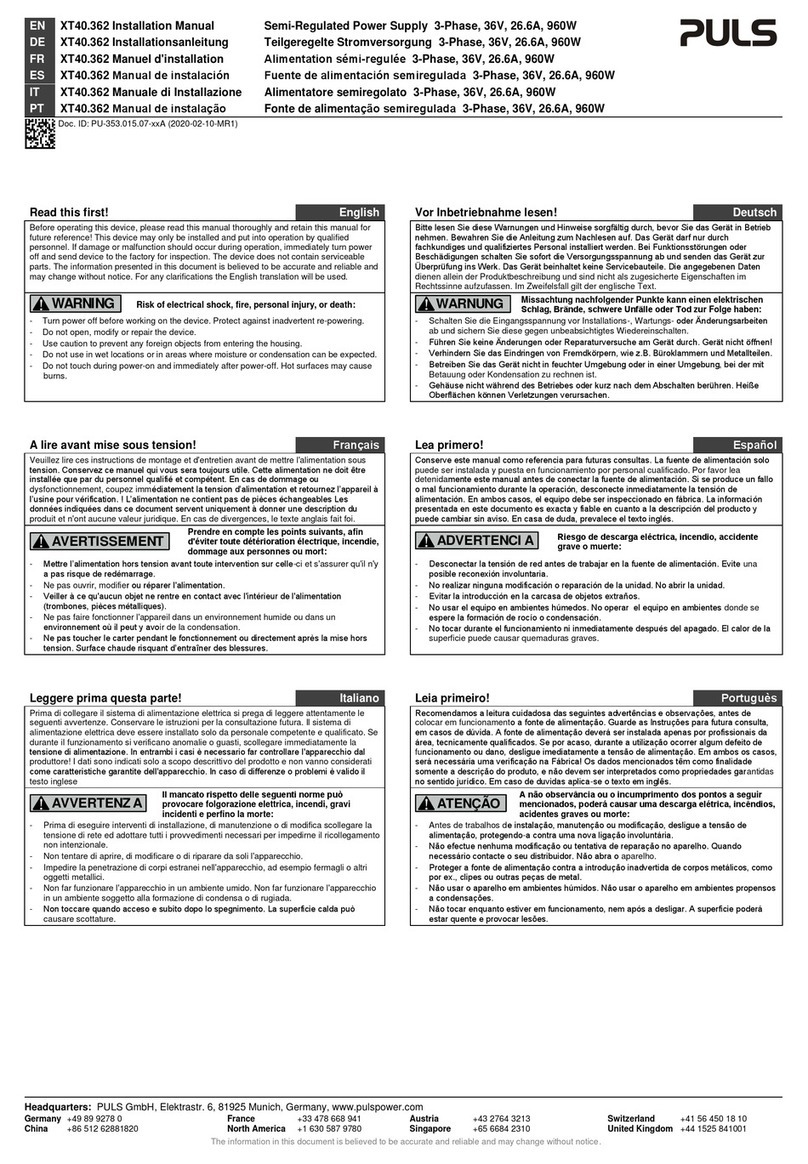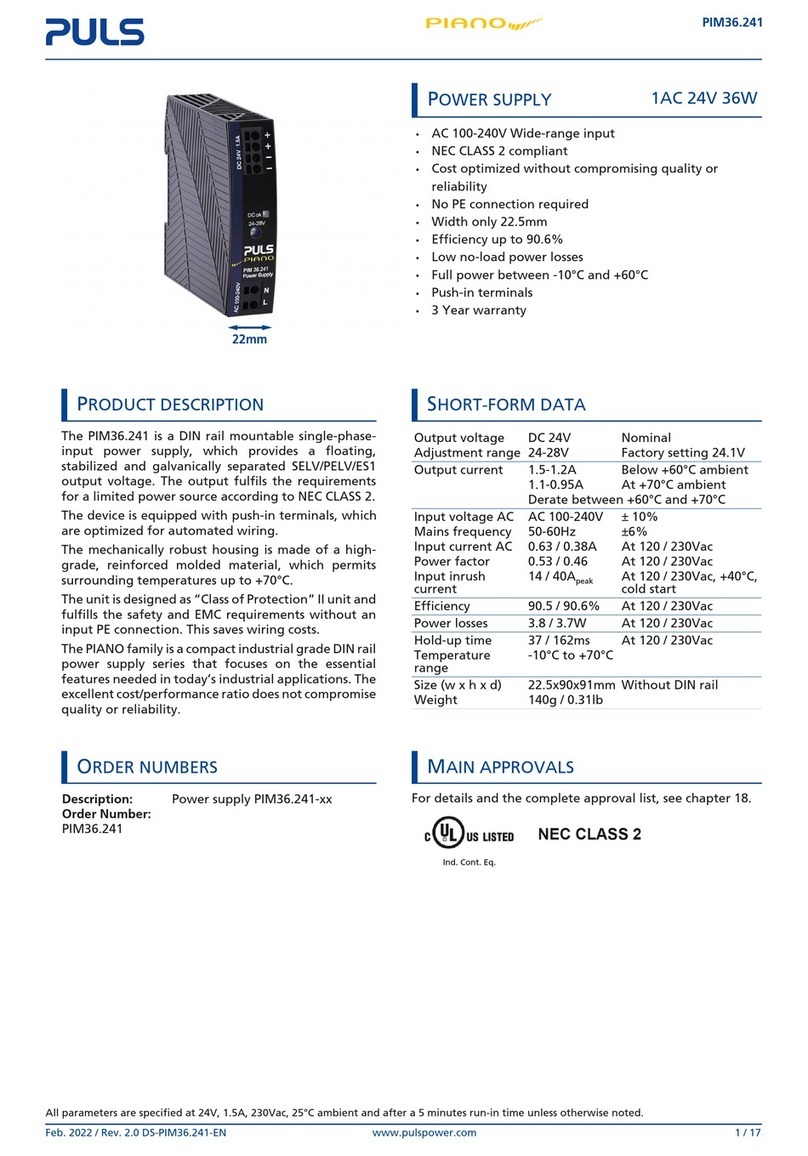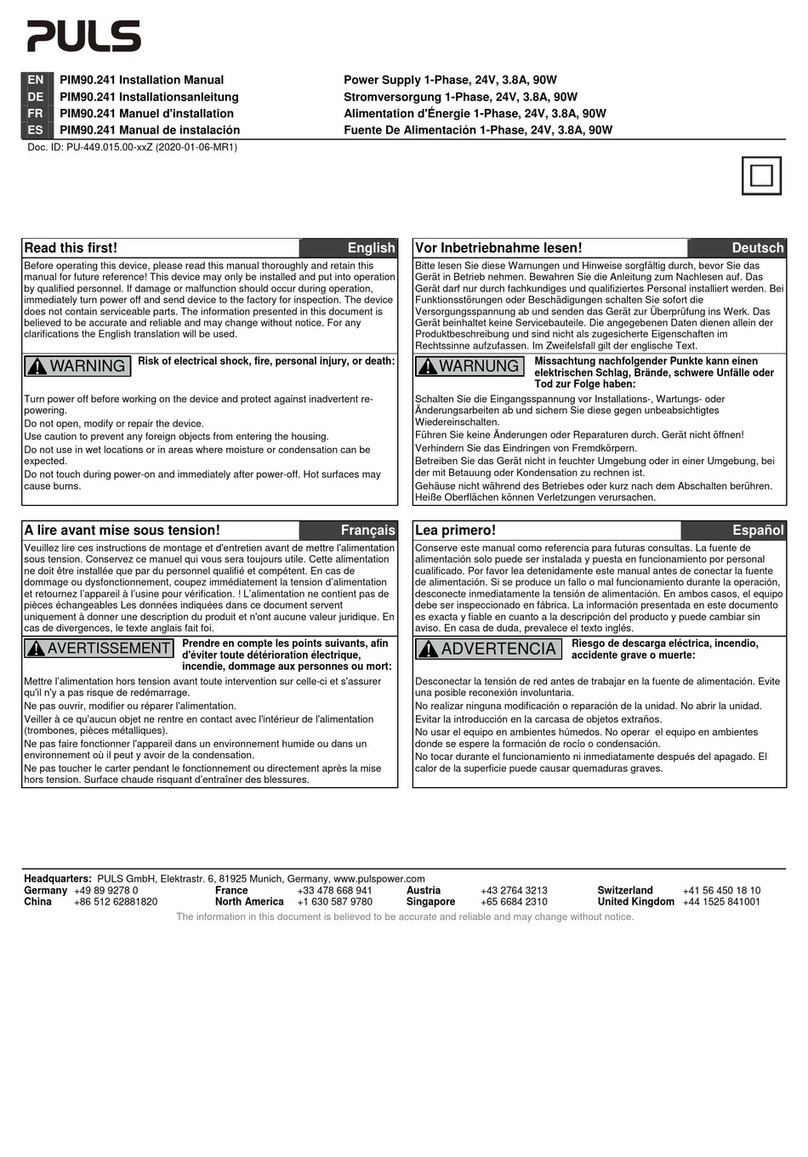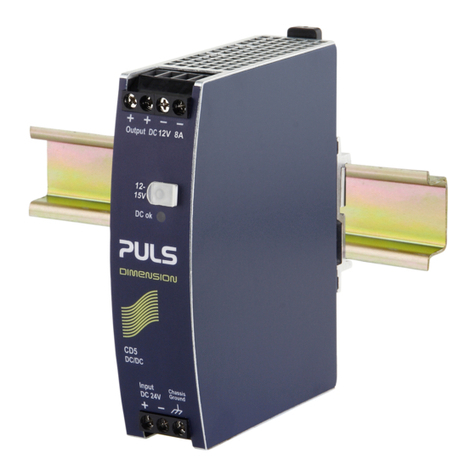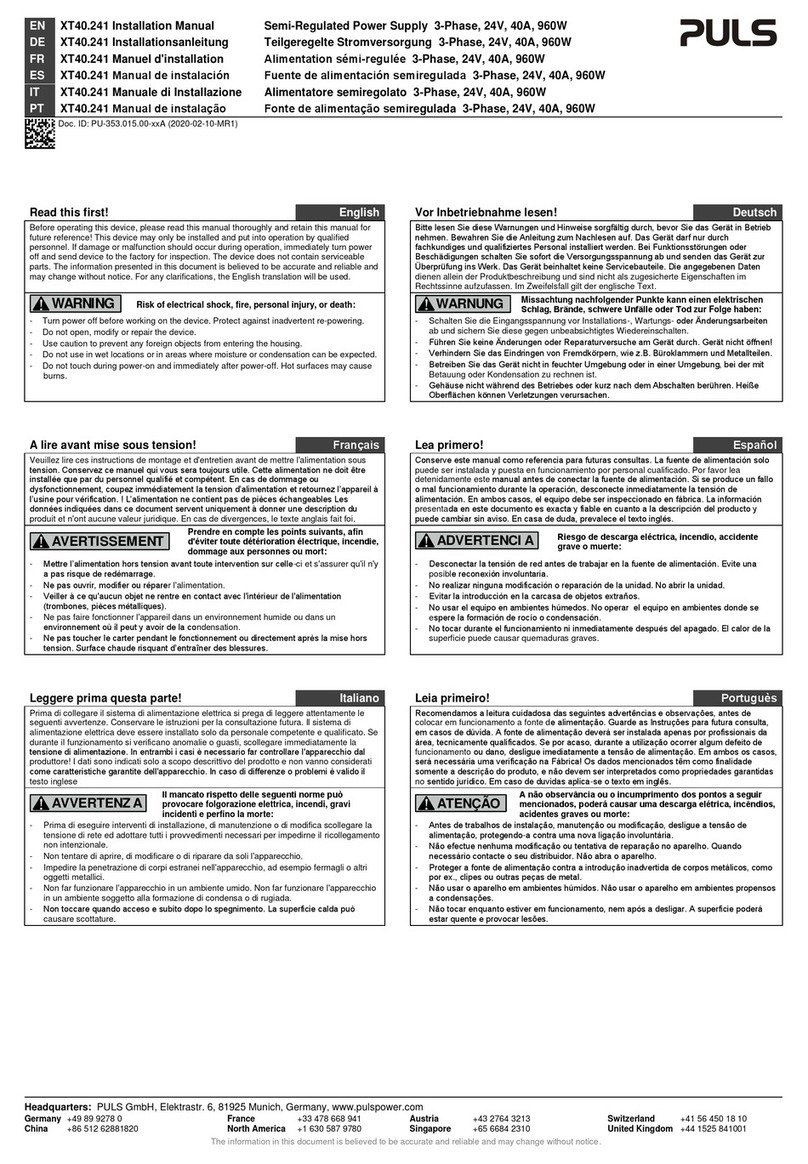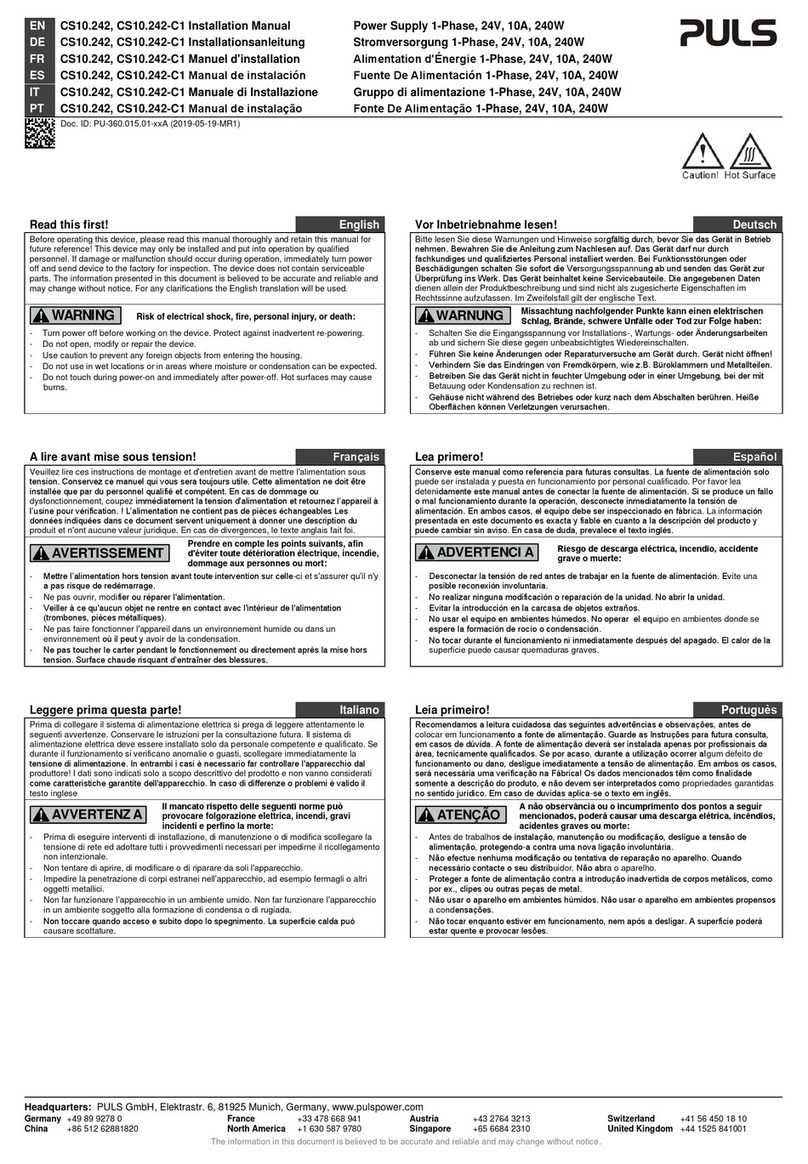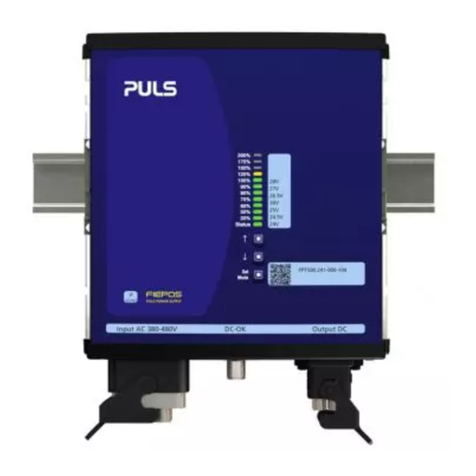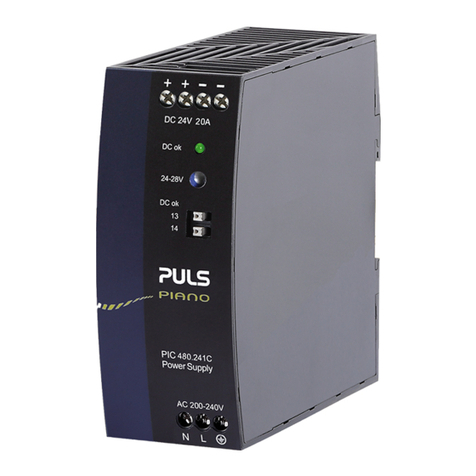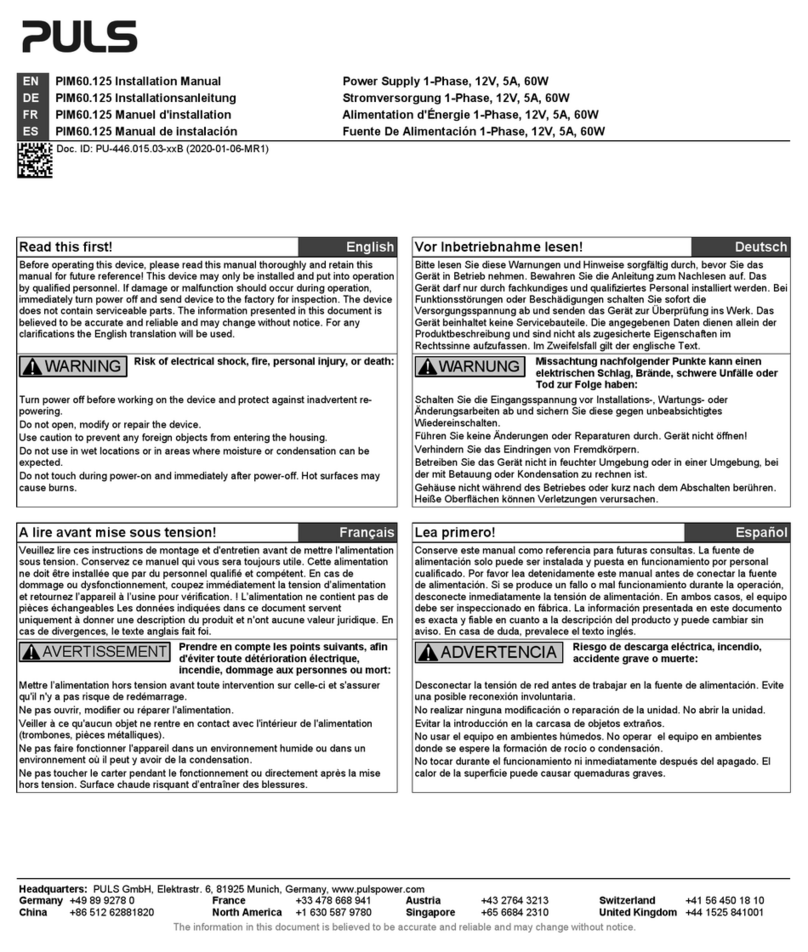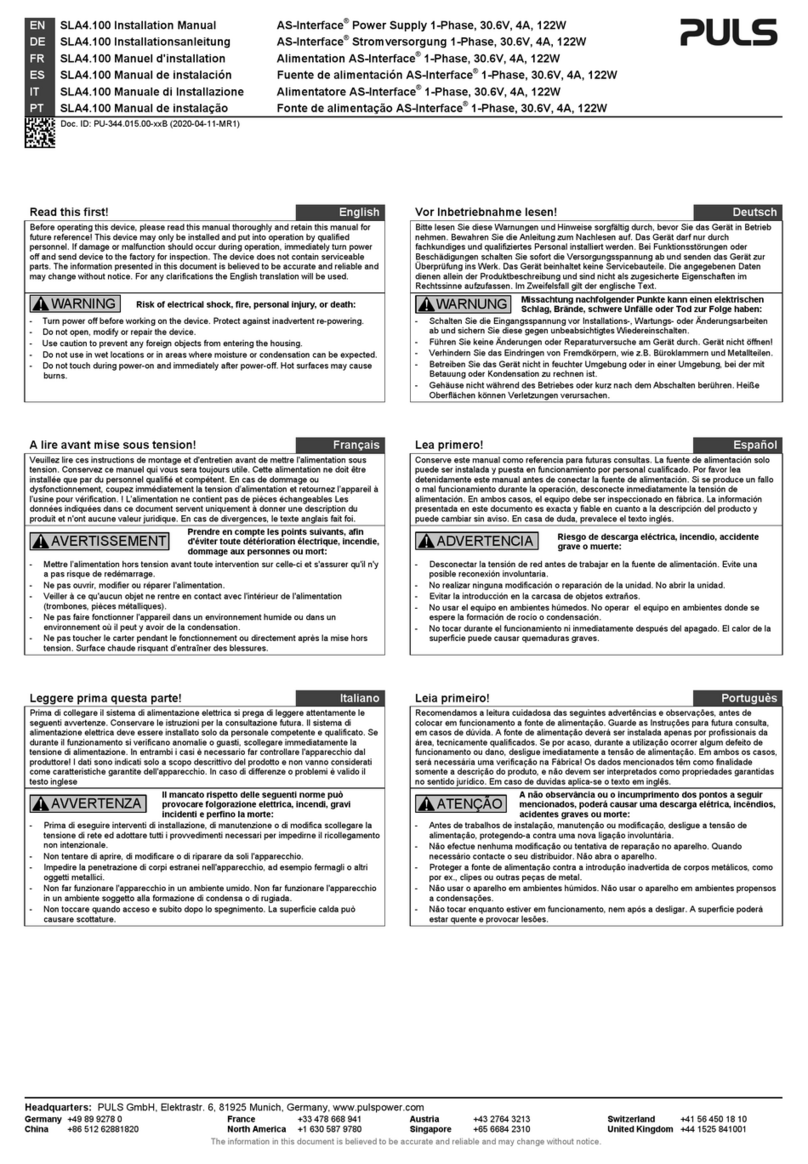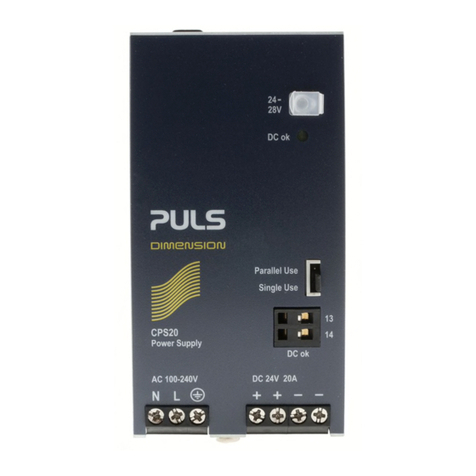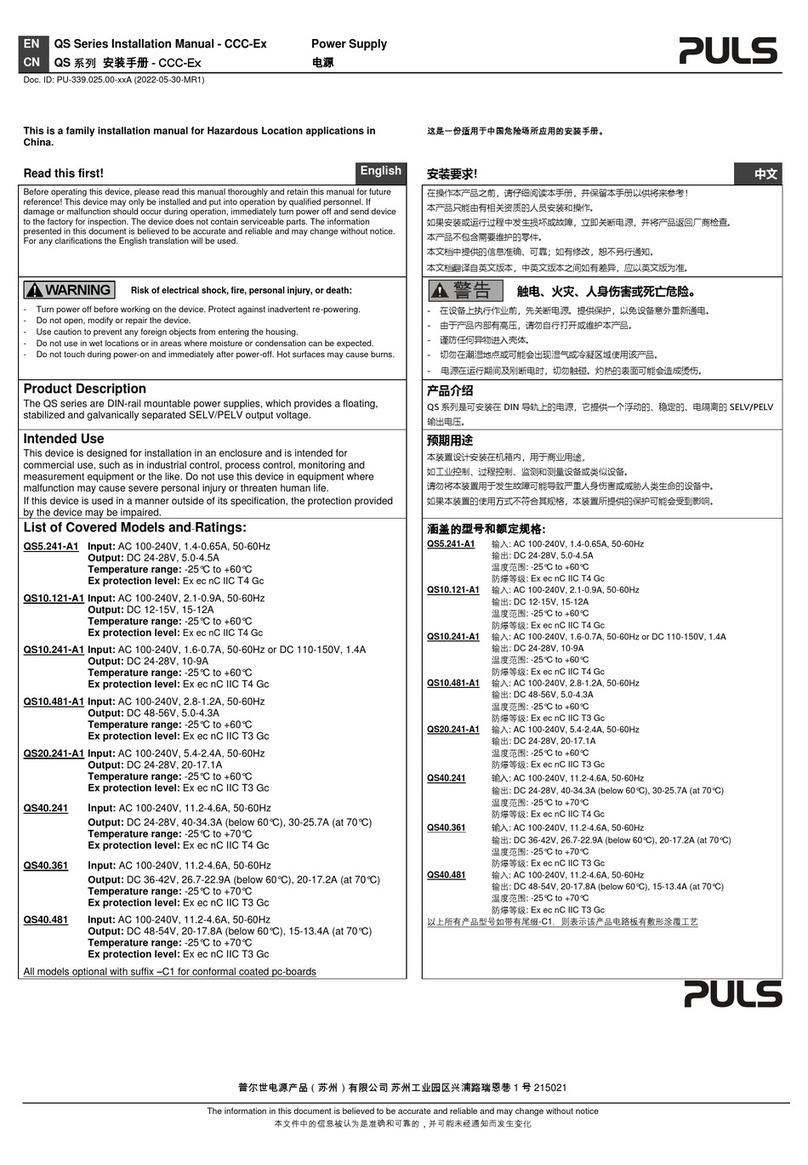
QS20 Power Supply Instruction Manual
QS20 Bedienungsanleitung für Stromversorgung
Technical Data 1) Technische Daten
1) QS20.241 15)
QS20.241-C1
QS20.361 QS20.481 QS20.244
Output Voltage Ausgangsspannung nom. DC 24-28V DC 36-42V DC 48-55V DC 24-28V
Factory Setting Werkseinstellung typ. 24.1V 36.0V 48.0V 24.1V
Output Current continuous Ausgangsstrom dauernd nom. 20A (24V), 17A (28V) 13.3A (36V), 11.4A (42V) 10A (48V), 8.7A (55V) 20A (24V), 17A (28V)
Output Current for typical 4s Ausgangsstrom für typisch 4s nom. 30A (24V), 26A (28V) 20A (36V), 17.1A (42V) 15A (48V), 13A (55V) 30A (24V), 26A (28V)
Output Power continuous Ausgangsleistung dauernd nom. 480W 480W 480W 480W
Output Power for typical 4s Ausgangsleistung für typisch 4s nom. 720W 720W 720W 720W
Output Ripple & Noise Voltage 2) Ausgangswelligkeit
2) max. 100mVpp 100mVpp 100mVpp 100mVpp
AC Input Voltage AC Eingangsspannung nom. AC 100-240V AC 100-240V AC 100-240V AC 200-240V
tolerance Toleranz ±15% ±15% ±15% ±15%
AC Input Current AC Eingangsstrom typ. 4.56A / 2.48A
3) 4.56A / 2.48A
3) 4.56A / 2.48A
3) 4.45A
11)
Power Factor Leistungsfaktor typ. 0.95 / 0.90 3) 0.95 / 0.90 3) 0.95 / 0.90 3) 0.5
11)
EN 61000-3-2 EN 61000-3-2 Yes / Ja Yes / Ja Yes / Ja No / Nein
Input Inrush Current Einschaltspitzenstrom typ. 9A / 7A peak 4) 3) 9A / 7A peak 4) 3) 9A / 7A peak 4) 3) 40A peak
11) 12)
DC Input Voltage 7) DC Eingangsspannung
7) 88 – 375Vdc 88 – 375Vdc 88 – 375Vdc -
Hold-up Time Pufferzeit typ. 32ms / 51ms
3) 32ms / 51ms
3) 32ms / 51ms
3) 46ms
11)
Efficiency Wirkungsgrad typ. 92.4% / 93.9%
3) 92.5% / 94.0%
3) 92.8% / 94.3%
3) 94.5%
11
Power Losses Verlustleistung typ. 39.6W / 31.4W
3) 38.9W / 30.6W
3) 37.2W / 29.0W
3) 28.3W
11
Operational Temperature Range Betriebstemperaturbereich -25°C - +70°C -25°C - +70°C -25°C - +70°C -25°C - +70°C
Output Derating (60°C to 70°C) Leistungsrücknahme (60°C to 70°C) 12W/°C 12W/°C 12W/°C 12W/°C
Storage Temperature Range Lagertemperaturbereich -40°C - +85°C -40°C - +85°C -40°C - +85°C -40°C - +85°C
Humidity 5), IEC 60068-2-30 Feuchte
5), IEC 60068-2-30 5 - 95% r.H. 5 - 95% r.H. 5 - 95% r.H. 5 - 95% r.H.
Vibration, IEC 60068-2-6 Schwingen, IEC 60068-2-6 2g 2g 2g 2g
Shock, IEC 60068-2-27 Schocken, IEC 60068-2-27 30g 6ms, 20g 11ms 30g 6ms, 20g 11ms 30g 6ms, 20g 11ms 30g 6ms, 20g 11ms
Degree of Pollution, EN 50078 Verschmutzungsgrad, EN 50178 2 2 2 2
Degree of Protection, EN 60529 Schutzart, EN 60529 IP20 IP20 IP20 IP20
Class of Protection, IEC 61140 Schutzklasse, IEC 61140 I
6) I
6) I
6) I
6)
Over-temperature Protection (OTP) Übertemperaturschutz (OTP) Yes / Ja Yes / Ja Yes / Ja Yes / Ja
Output Over-voltage Protection (OVP) Ausgangsseitiger Überspannungsschutz (OVP) typ. 32Vdc 50Vdc 59Vdc 32Vdc
Resistance against Return Voltages 8) Rückspeisefestigkeit
8) max. 34Vdc 48Vdc 58Vdc 34Vdc
Parallel Use 13) Parallelschaltbar
13) Yes / Ja Yes / Ja Yes / Ja Yes / Ja
Serial Use 14) Serienschaltbar
14) Yes / Ja Yes / Ja Yes / Ja Yes / Ja
Dimensions 9) (wxhxd) Abmessungen
9) (BxHxT) nom. 82x124x127mm 82x124x127mm 82x124x127mm 70x124x127mm
Weight Gewicht max. 1200g 1200g 1200g 880g
Approvals Zulassungen 10) 10) 10) 10)
Limited Warranty (Year) Gewährleistung (Jahre) 3 3 3 3
1) All parameters are specified at 230Vac input voltage, nominal output current, 25°C ambient and after a 5
minutes run-in time unless otherwise noted.
2) 50 Ohm measurement, bandwidth 20MHz
3) at 120Vac / 230Vac
4) Input inrush current electronically limited and is temperature independent.
5) Do not energize while condensation is present.
6) PE connection required (Ground).
7) Use a battery or similar DC source. Connect +pole to L and -pole to N.
8) Loads such as decelerating motors and inductors can feed voltage back to the output of the power supply.
The figure represents the maximum allowed feed back voltage
9) Depth without DIN-rail.
10) See datasheet or markings on the unit.
11) at 230Vac
12) Peak value at an ambient temperature of 40°C, 230Vac and cold start.
13) A fuse (or diode) on the output is only required if more than three units are paralleled.
14) Use only power supplies of the same type. The total output voltage should not exceed 150Vdc.
15) The models with the extension –C1 are identical to the standard models with the exception that PC board
is conformal coated.
1) Alle Werte gelten bei 230Vac Eingangsspannung, Nennausgangsstrom, 25°C Umgebung und nach
einer Aufwärmzeit von 5 Minuten, wenn nichts anderes angegeben ist.
2) 50 Ohm Messung, Bandbreite 20MHz
3) Bei 120Vac / 230Vac
4) Der Einschaltstromstoß ist elektronisch begrenzt. Der Wert ist unabhängig von der Temperatur.
5) Nicht betreiben, solange das Gerät Kondensation aufweist.
6) PE Verbindung erforderlich.
7) Geeignet sind Batterien oder ähnliche Quellen. Den + Pol an L und - Pol an N anschließen.
8) Bremsende Motoren oder Induktivitäten können Spannung zum Ausgang des Netzteils rückspeisen.
Der Wert gibt die max. zulässige Rückspeisespannung an.
9) Tiefe ohne DIN-Schiene
10) Siehe Datenblatt oder Prüfzeichen auf dem Gerät.
11) Bei 230Vac
12) Spitzenstrom bei einer Umgebungstemperatur von 40°C, 230Vac und Kaltstart.
13) Bei mehr als drei Geräten wird eine Sicherung oder eine Diode zur Entkopplung benötigt.
14) Nur gleiche Geräte bis zu einer Gesamtspannung von 150Vdc
15) Modelle mit der Erweiterung –C1 sind identisch zum Standardgerät mit der Ausnahme, dass die
Leiterkarte schutzlackiert ist.
Installation
Use DIN-rails according to EN 60715 or EN 50022 with a height of 7.5 or 15mm.
Mounting orientation must be output terminals on top and input terminals on the bottom. For other
orientations see datasheet. Do not obstruct air flow! The unit is convection cooled. Ventilation grid
must be kept free of any obstructions. The following installation clearances must be kept when
permanently full loaded:
Left / right: 5mm (15mm in case the adjacent device is a heat source)
40mm on top, 20mm on the bottom
Terminals and Wiring
The power supplies are equipped with quick-connect spring-clamp terminals. Use appropriate
copper cables that are designed for an operating temperatures of 60°C (for ambient up to 45°C) and
75°C (for ambient up to 60°C), minimum. Follow national installation codes and regulations! Ensure
that all strands of a stranded wire enter the terminal connection! Up to two stranded wires with the
same cross section are permitted in one connection point (except PE wire). Ferrules are allowed,
but not required.
Input and output terminals:
Solid wire / Stranded wire / American wire gauge: 0.5-6mm2 / 0.5-4mm2 / 20-10 AWG
Wire stripping length: 10mm / 0.4inch; Pull-out force (UL 486E): 10AWG: 80N, 12AWG: 60N
DC-OK terminals:
Solid wire / Stranded wire / American wire gauge: 0.3-4mm2 / 0.3-2.5mm2 / 26-12 AWG
Wire stripping length: 6mm / 0.25inch; Pull-out force (UL 486E): 12AWG: 60N, 14AWG: 50N
Installation
Geeignet zur Montage an DIN-Schienen entsprechend EN 60715 oder EN 50022 mit einer
Höhe von 7,5 oder 15mm. Der Einbau hat so zu erfolgen, dass sich die Eingangsklemmen
unten und die Ausgangsklemmen oben befinden. Für andere Einbaulagen siehe Datenblatt.
Das Gerät ist für Konvektionskühlung ausgelegt. Es ist für eine ungehinderte Luftzirkulation zu
sorgen. Die folgenden Einbauabstände sind bei dauerhafter Volllast einzuhalten:
Links / rechts: 5mm (15mm wenn das benachbarte Geräte eine Wärmequelle ist)
Oben: 40mm, unten 20mm
Anschlussklemmen und Verdrahtung
Die Stromversorgungen sind mit Schnellanschluss-Federkraftklemmen ausgestattet.
Verwenden Sie geeignete Kupferkabel, die mindestens für 60°C (bei einer
Umgebungstemperatur bis zu 45°C) und 75°C (bei einer Umgebungstemperatur bis zu 60°C)
zugelassen sind. Beachten Sie nationale Bestimmungen und Installationsvorschriften! Stellen
Sie sicher, dass keine einzelnen Drähte von Litzen abstehen. Bis zu zwei Leiter mit gleichem
Querschnitt sind in einem Anschlusspunkt zulässig (außer für den Schutzleiter). Aderendhülsen
sind erlaubt, aber nicht erforderlich.
Eingangs- und Ausgangsklemmen:
Starrdraht / Litze / Amerikanischer Querschnitt: 0.5-6mm2 / 0.5-4mm2 / 20-10 AWG
Abisolierlänge: 10mm / 0.4inch; Abziehkraft (UL 486E): 10AWG: 80N, 12AWG: 60N
DC-OK Klemmen:
Starrdraht / Litze / Amerikanischer Querschnitt: 0.3-4mm2 / 0.3-2.5mm2 / 26-12 AWG
Abisolierlänge: 6mm / 0.25inch; Abziehkraft (UL 486E): 12AWG: 60N, 14AWG: 50N
EMC Electromagnetic Compatibility
These devices are suitable for applications in industrial environment as well as in residential,
commercial and light industry environment. Please note that for the QS20.244 restrictions may apply
since the EN 61000-3-2 requirements are not fulfilled. See datasheet for details.
These devices comply with FCC Part 15 rules. Operation is subjected to following two conditions: (1)
this device may not cause harmful interference, and (2) this device must accept any interference
received, including interference that may cause undesired operation.
CE mark is in conformance with EMC directive 89/336/EC, 93/68/EC and 2004/108/EC and the low-
voltage directive (LVD) 73/23/EC, 93/68/EC, 2006/95/EC.
EMC Immunity: EN 61000-6-1, EN 61000-6-2
EMC Emission: EN 61000-3-2 (except QS20.244), EN 61000-3-3, EN 61000-6-3 (except
QS20.244), EN 61000-6-4, FCC Part 15 Class B
EMV Elektromagnetische Verträglichkeit
Diese Geräte erfüllen die Anforderungen für Anwendungen sowohl in industrieller Umgebung
als auch für den Wohn-, Geschäfts- und Gewerbebereich.
Das QS20.244 erfüllt die Anforderungen der EN 61000-3-2 nicht und es kann daher zu
Einschränkungen bei gewissen Anwendungen kommen Siehe Details auch im Datenblatt.
Die Geräte erfüllen auch die Anforderungen der FCC Teil 15.
Das CE Zeichen ist angebracht und erklärt die Erfüllung der EMV Richtlinien 89/336/EG,
93/68/EG, 2004/108/EG und der Niederspannungsrichtlinien 73/23/EG, 93/68/EG, 2006/95/EG.
EMV Störfestigkeit: EN 61000-6-1, EN 61000-6-2
EMV Störaussendung: EN 61000-3-2 (außer QS20.244), EN 61000-3-3, EN 61000-6-3
(außer QS20.244), EN 61000-6-4, FCC Part 15 Klasse B
